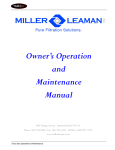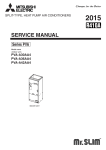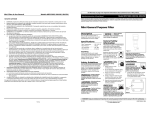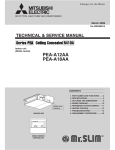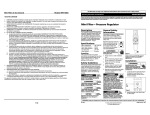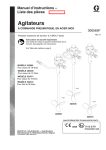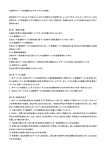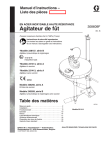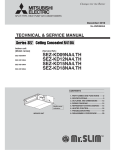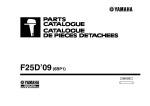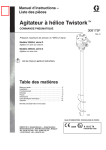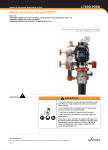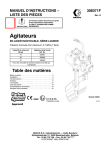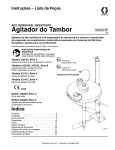Download cg-550/030/a/gt/hp maintenance & operating
Transcript
CG-550/030/A/GT/HP MAINTENANCE & OPERATING INSTRUCTIONS WITH REPAIR PARTS LIST SERIAL #______________________________ SAFETY DATA PLEASE READ AND HEED THE FOLLOWING IMPORTANT SAFETY NOTICES BEFORE PLACING MACHINE IN SERVICE. * * * * NOTICE * * * * PROPER PERSONAL PROTECTIVE EQUIPMENT, INCLUDING, BUT NOT LIMITED TO: GOGGLES, DUST MASKS OR RESPIRATORS, GLOVES, HARD HAT, BOOTS AND RAINGEAR MUST BE WORN WHEN OPERATING THIS EQUIPMENT. * * * * NOTICE * * * * FOLLOW MATERIAL MANUFACTURER’S INSTRUCTIONS FOR PROPER MATERIAL USE AND RECOMMENDATIONS FOR SAFETY EQUIPMENT AND PROCEDURES. * * * * WARNING * * * * NEVER PUT HANDS OR TOOLS IN MIXERS OR PUMP UNLESS PRIMARY POWER SOURCE IS SHUT OFF AND DISCONNECTED AND KINETIC ENERGY DISSIPATED. ON ELECTRICALLY POWERED EQUIPMENT, USE PROPER LOCK OUT/TAG OUT PROCEDURES. FAILURE TO OBSERVE THIS WARNING COULD RESULT IN SERIOUS PERSONAL INJURY AND/OR DAMAGE TO THE MACHINE. * * * * WARNING * * * * NEVER ATTEMPT TO DISCONNECT OR OPEN THE COUPLING ON ANY PART OF THE PUMP DISCHARGE SYSTEM WHILE PUMP IS IN OPERATION, OR IF THE DISCHARGE SYSTEM IS UNDER PRESSURE FOR ANY REASON. * * * * WARNING * * * * NEVER OPERATE MACHINE WITHOUT THE VARIOUS GUARDS, SHIELDS AND OTHER SAFETY EQUIPMENT WITH WHICH THE MACHINE WAS ORIGINALLY EQUIPPED IN PLACE AND FUNCTIONAL. * * * * WARNING * * * * ALL ELECTRICAL CONNECTIONS MUST BE MADE BY A QUALIFIED ELECTRICIAN. * * * * WARNING * * * * HYDRAULIC COMPONENTS, INCLUDING, BUT NOT LIMITED TO VALVES, FITTINGS, HOSES, MOTORS, RESERVOIR AND FILTERS MAY BE HOT. TO PREVENT INJURY, TOUCH ONLY THE HANDLES PROVIDED. LET THE HYDRAULIC COMPONENTS COOL BEFORE SERVICING THE EQUIPMENT. ® WARRANTY STATEMENT ChemGrout, Inc. warrants that equipment shall be free from defects in material, workmanship or components. The period of this warranty shall be limited to 90 days from the date of purchase and the extent of ChemGrout's liability shall be limited to replacement of components that have been proven faulty. No claims in excess of component replacement value will be recognized. Specifically excluded from this warranty is normal wear resulting from the mixing and pumping of abrasive slurries or damage to the equipment as a result of improper use. SAFETY Various guards, shields, grates and screens are provided over moving parts, such as: sheaves, couplings, augers, paddles, belts, etc. to guard against injury to operators while the equipment is in operations. Warning stickers are provided to remind operators of the potential hazards. Operators are advised to utilize appropriate personal safety equipment including, but not limited to, saftey glasses or goggles, dust masks or respirators, gloves and / or rain gear and hard hats when operating this equipment. LIABILITY It is understood and agreed that ChemGrout is relieved of any and all liability that may arise from personal injury or damage to property as a direct or proximate result of the removal of protective guards, shields, etc., the ignoring of warning signs and the lack of common sense procedures. ® TABLE OF CONTENTS SECTION SUBJECT 1. GENERAL DESCRIPTION 2. OPERATING INSTRUCTIONS 3. GROUT SUGGESTIONS 4. DIAGRAM & REPAIR PARTS LIST 5. GROUT PUMP INSTRUCTIONS 6. AIR MOTOR INSTRUCTIONS ® SECTION 1 GENERAL DESCRIPTION ® CG-550/030/A/GT/HP GENERAL DESCRIPTION The ChemGrout Model CG550/030/A/GT/HP is a pneumatically powered, skid mounted cement grout plant specially designed and constructed for application in the geothermal industry. The machine consists of one 70 gallon capacity vertical shaft paddle mixer and one CG-030 single acting piston type grout pump. An oversize 6” diameter mixer discharge gate facilitates discharge of thick mixes into a 50 gallon capacity hopper situated directly above the pump. The grout pump is driven by a 8” diameter selfreciprocating cylinder, which allows the pump to produce discharge rates up to 16 GPM and pressures up to 700 PSI. The extra large capacity hopper makes continuous operation possible. A 30 gallon capacity water batcher (OPTIONAL) is installed over the mixing tank to facilitate quick batching. All pump components are assembled with horseshoe shaped pins making assembly and disassembly for cleaning and maintenance easily accomplished with no special tools required. Simplicity of design and construction ensures years of dependable service with proper and timely maintenance. Dimensions: 76” X 31” X 51” (78” with water batcher.) Weight: 750 lbs ® SECTION 2 OPERATING INSTRUCTIONS ® OPERATING INSTRUCTIONS GENERAL * * * * WARNING * * * * NEVER PUT HANDS OR TOOLS IN MIXERS OR PUMP UNLESS PRIMARY POWER SOURCE IS SHUT OFF AND DISCONNECTED. FAILURE TO OBSERVE THIS WARNING COULD RESULT IN SERIOUS PERSONAL INJURY AND/OR DAMAGE TO THE MACHINE. SET-UP In general, the most important factors in setting up are proximity to the work and access to materials and water supply; consideration should be given to the disposal of waste materials and wash-out residue. It is always best to keep grout lines as short as possible to reduce pumping distances. This is particularly important when pumping hard-to-pump materials, such as sanded grouts and pre-blended materials. The source of solid materials (cement, fly ash, sand, etc.) should be readily accessible and an adequate supply of water should be available for mixing and clean-up. When planning a project for high production rates, it is well to remember that the greatest consumption of time occurs when charging the mixers. A proper set-up can reduce this to a minimum. START-UP After set up, visually inspect that there are no foreign objects or old set up materials in either the pump or the mixer(s), then make all necessary connections. With operating levers, valves, or handles in either "NEUTRAL" or "OFF" position and the primary power source turned OFF, fill the pump hopper with clear water. NOTE: It may be necessary to elevate the discharge hose during this operation to prevent water exiting through the ball valves. ® OPERATING INSTRUCTIONS (cont'd) Turn on the primary power source and observe that conditions are normal and machine is ready to run. Check each mixer for proper operation by running the mixer in both forward and reverse directions, if unit is so constructed as to allow reverse direction. Next, start the delivery pump to discharge the water that was previously introduced into the pump hopper. This is an ideal opportunity to check the grouting system to determine that all lines and hoses are clear and unobstructed. Pump condition may also be checked at this time by testing discharge pressure. When it is determined that all systems are normal, shut off the pump and drain the water from the pump and all lines. NOTE: Some pre-blended materials and some on-site mixes of sand and cement tend to separate and clog the hoses upon contact with residual water. To prevent this occurrence, it's a good procedure to mix and pump out a cement/water slurry prior to mixing and pumping the production material, to lubricate the pump and hoses. PRODUCTION During the production phase of the work, monitor pump and mixer performance continuously, being alert to any signs of abnormality. Keep mixers free of material build-up, keep the outside of the machine clean, and keep pump packing lubricated and just tight enough to prevent leakage. (Section 5) CLEAN-UP After disposing of excess production materials, carefully wash out mixer tanks, paddles and baffles into the pump hopper and pump the resulting washout material through the grout hoses to a suitable disposal site. Continue this operation until only clear water is discharged. It is advisable to drain all residual wash water from the pump and all hoses when washout is complete. CAUTION: NEVER RUN PUMP WITHOUT FLUID AS IT WILL CAUSE SEVERE DAMAGE TO PISTON AND SLEEVE. ® SECTION 3 GROUT SUGGESTIONS ® Please note that the information contained in this section is general in nature, and not specific to geothermal materials, which possess their own unique characteristics and preparation procedures. ® MIXING AND PUMPING SUGGESTIONS NOTE: The suggestions offered herein are intended as an aid to help the operator identify some of the factors that need to be taken into consideration when mixing and pumping cementitious grouts. Because a wide variety of materials are available for many different applications, it is incumbent upon the operator to become familiar with the specific characteristics of the material he intends to use. MATERIALS Among the commercially manufactured materials available in today’s market are materials for structural repairs, floor toppings, high strength non-shrink grouts, manhole and sewer lining mortars and other specialty materials. Each of these materials has unique characteristics, which must be well understood to insure a successful application. FLOW In general, most materials need to be of a flowable or pourable consistency for successful pumping. This means that if the material can be poured out of a pail or bucket, it can likely be pumped. The exception to this requirement is repair mortars, which tend to be mixed in a thicker consistency and require special pumping techniques. Materials that contain aggregates pump best and perform best when the consistency is kept to the lower range of pourable; that is, not too wet. SETTING TIME Some materials contain accelerating admixtures to reduce the setting time. This is particularly true of repair mortars and other spray applied materials so that strength gain can be fairly rapid. It is important to keep moving when using these types of materials. Once the material is mixed, it must be pumped immediately and kept in motion and subsequent batches must be mixed and pumped as rapidly as possible. Any delays in the application process could result in plugged hoses and equipment. Temperature also has an effect upon these materials to the extent that exposure of the hose to the sun on a hot day will accelerate the set time even more; therefore this should be avoided. It may even be necessary in some cases to cool the material, the mix water, or even the hose itself. PUMPING DISTANCE Pumping distances should always be kept to a minimum, and hoses should run as straight as possible no matter what material is being used. Sometimes circumstances require longer than usual hose lengths; when this occurs, every effort should be made to use every advantage possible to insure a successful application. Some materials simply cannot be pumped for long distances, so it’s best to know the proposed material characteristics before attempting a production procedure. ® MIXING AND PUMPING SUGGESTIONS (Cont’d.) GENERAL PROCEDURES Before attempting to mix and pump production materials, it is prudent to rinse the mixer and charge the pump hopper with sufficient water to thoroughly flush the pump and all grout lines. This is to purge the grouting system of any residual materials or scale that may exist. Once that is completed, remove the grout hose from the pump and drain out all water by elevating one end, or by progressively elevating the entire hose, starting at one end and proceeding to the other. Next, mix a slurry composed of portland cement in approximate proportions of 6-1/2 to 7-1/2 gallons of water to one bag (94 lbs.) of cement, and pump this through the grouting system. This is to remove any residual water from the hose, lubricating it for the production material to follow. Now the production grout may be mixed and pumped immediately behind the slurry mix, which is thus evacuated from the hose, and may be retrieved in a bucket. Do not attempt to pump production material through a dry hose. Finally, one last word about procedures. Occasionally, no mater how conscientious an operator may be, a hose will get plugged. Once this happens, the only sure way to remove the plug is to empty it of material. Beating on it with a hammer or running over it with a vehicle will not usually be successful. A prudent operator will be prepared for such eventuality by having readily available a sufficient length of small diameter stiff tubing, hose or plastic pipe to which he can rapidly connect a water source and flush the grout from the hose. ® ADDITIONAL SUGGESTIONS “HOMEMADE” GROUT Sometimes commercially prepared grouts are not readily available, and in these cases it may be necessary to formulate and produce the material on site. This can be done quite successfully, but certain basic principles must be observed. The resultant material should exhibit the following characteristics: 1. A stable suspension of solids that does not separate while at rest. 2. Color must be predominantly that of the cement used. 3. Fluid enough to pour from a container but not too wet. (Thick batter consistency or thicker) CEMENT There are several types of Portland cements manufactured to satisfy a variety of specific requirements, such as high early strength, sulfate resistance and other needs. The most common of these is Type I Portland, and is that which is most frequently used in the production of cementitious grout. WATER In most instances, the water to be used for the production of grout should be clean and free of sulfates or other dissolved chemicals. If available, potable water is ideal. Since the water to cement ratio is the most important factor in the quality of the material in its final state, the water content should be kept to the minimum that will produce materials with the characteristics listed above. ADMIXTURES Admixtures are available to modify and enhance the grout mixture. These include plasticizers, water reducing agents, expansive agents, anti-washout ingredients, set time modifiers and others. Each of these admixtures are designed to impart specific properties to the grout. If used at all, they should be used only with a full understanding of their effects, and only according to the manufacturers’ recommendations. FLYASH In some parts of the country, flyash (a byproduct of coal burning power stations) is available. This material has often been used to enhance the properties of cementitious grouts or, in some cases to reduce the cement fraction. Use of this material should be approached with CAUTION, since ash from some sources have, in recent years, been observed to cause FLASH SET in grout mixes. If the use of this product is anticipated, trial mixes should be made to prove their applicability. ® ADDITIONAL SUGGESTIONS (Cont’d.) SAND Sand is often used in grout formulations either to increase the volume of the material, thus reducing the cost, or to act as an aggregate in the case of high-strength structural grouts. If the use of sand is anticipated, several factors must be considered such as the shape, size and gradation of the sand to be used. In general, the sand should be clean, well graded and of rounded, natural shape. Angular particles such as those found in manufactured sands should be avoided. Of all of the considerations when anticipating the use of sand in a grout mixture intended to be pumped, one of the most important is gradation. Gradation of a sand sample is determined by a sieve analysis, which reveals the percentages of each individual particle size of which the sand is composed. Laboratory tests and field experience shows that some sand gradations will pump better than others, and some will pump only with difficulty, if at all. Sample sieve analysis data is offered herein as a guide to choosing sand that has a good chance of producing a strong, pumpable grout mix. Another factor to take into consideration when choosing a sanded grout over a slurry grout is the volume, or amount of sand that can be used in the mix. This will vary as a function of the gradation, but in general will usually be in the proportion of 1-1/2 to 2 times the cement content by VOLUME. In rare cases, it may be possible to exceed this proportion, but caution should be exercised. Grouting Sand Gradation Specifications Sieve Size % Passing #8 #16 #30 #50 #100 #200 100 90-100 55-80 30-55 10-30 0-10 NOTE: The suggestions above are primarily for conventional portland cement based grouts. It is recognized that geothermal work utilizes special mixes, therefore, it is incumbent upon the operator to learn the characteristics of the material he will be using. ® U. S. Standard Sieve Numbers 100 3/8 4 8 16 30 50 100 200 0 10 90 Materials with gradation curves to the right 80 20 70 30 60 40 50 50 40 60 Materials with gradation curves to the left of these limits usually are NOT pumpable. 30 70 20 80 10 90 0 10 5 1 0.5 Particle Size in Millimeters ® 0.1 0.05 100 0.03 Percent Retained by Weight Percent Passing by Weight of these limits usually ARE pumpable. SECTION 4 DIAGRAM & REPAIR PARTS LIST ® 14 15 17 27A 17A 18 10 10A 21 22 19 23 19A 20 3 3A 3B 2 34 9 16 33 2A 31A 24 28 28A 7 32 25 29 31 26 1 6 CG-550/030/A/GT CG-550/030/A/GT/HP COMPONENT PARTS LIST REF # 1 2 2A 3 3A 3B 6 7 9 10 10A 14 15 14* 15* 16 17 17A 18 19 19A 20 21 22 23 24 25 26 27A 28 28A 29 31 31A 32 33 34 PART # 63030A 21030SCN50 21030HOP50 846SLIDE 546GATEGASK 33TBC7112 06CYL8X7 84030RELIEF 06NAN5000N06 06M05 06M05A 046AMNRV11 04K208 04SM6AMAN 04SM6AMA-TK1 06LUB15 30SW050T 21WINBASE 21PADCPLGH 2130PAD 21PADBUSH 21PADPIN 2130BAGBKR 2130COV 84BBLV50 542VICT#77 33EV11/4ABR 21050REDUCE11/4 2130DUSTCOV 33AM13 06CRAP2 06NAF5000N010 06NAL5000N010 06FRL1 841BBALL 06NVSA-ALT 061/8CHECK DESCRIPTION Grout Pump Hopper Screen Hopper 6" Slide Valve Assembly Discharge Gate Gasket T Bolt Gasket Clamp 8” X 7” Air Cylinder Grout Pressure Relief Valve Exhaust Silencer ½” Muffler Replacement Element Mixer Air Motor (Gast) Air Motor Repair Kit (Gast Motor only) Alternate Air Motor (Ingersoll Rand) Repair Kit (Ingersoll Rand) ¾” ASL Air Line Oiler 15:1 Gearbox Gearbox Base 1” Paddle Coupling Mixer Paddle Paddle Bushing Paddle Pin Mixer Guard / Bag Breaker Cover For 27" Mix Tank Mixer Air Valve 2” Victualic Clamp 1-1/4” Part A Evertite Coupling 2” to 1 ¼” Reducer Mixer Cover 1” Air Connection 30 Mesh Air Filter 1” Air Line Filter 1” Air Line Lubricator 1” Filter/Regulator/Lubricator Assembly Pump Control Valve Directional Control Valve 1/8” Brass Check Valve * Machine may be equipped with Gast or I/R motor. ** Complete sets of warning labels are available upon request ® SECTION 5 GROUT PUMP INSTRUCTIONS ® 13 15 26 17 20 18 5B 12 27 27 16 21 14 6A 5 10 3A 22 7A 3 10C 6 4 6A 3A 1A 2A 2 10E 9A 22 19 8 10B 9 11 3 10A 7 3A 4 2B 1 2A 3 CG-030/A/HP Parts Diagram 2C CG-030/A/HP COMPONENT PARTS LIST REF. 1 1A 2 2A 2B 2C 3 3A 4 5 5A 6 6A 7 7A 8 9 9A 10 10A 10B 10C 10E 11 12 13 14 15 16 17 18 19 20 21 22 26 27 ® PART NO. DESCRIPTION 21030REDUCER-02C 24030RBOLT 21050REDUCE11/4 542VICT#77 33EV11/4ABR 84030RELIEF 21030STAPLE 33EV3GASK 21030BALL See Main Parts List See Main Parts List 21030BALLSEAT3 21030RING 21030TEE 24030TBOLT 21030SLEEVE 21030CYLBKTA 21030CYLBKTAHP 07030PIST 21030PISTBP 21030PISTSP 21030PISTCUP 243/4X10JAMNUT 21030AIRADAPT 06NAN500N06 06FRL1 06NAR5000N010 06NAL5000N010 06NAF5000N010 841BBALL 33AM13 06CYL8X7 06CRAP2 06NVSA-ALT 06VR370 292160 061/8CHECK CG-030 Reducer (3” X 2” Victaulic) CG030 Reducer Bolt (3/8-16 X 3-1/3) 2” Victaulic X 1-1/4” NPT Reducer 2” Victaulic Coupling (With Gasket) 1-1/4” Part A Evertite Coupling Grout Pressure Relief Valve CG-030 Staple Pin Coupling Gasket 2-5/8” Polyurethane Ball Hopper Hopper Screen CG-030 Ball Seat “O” - Ring For Ball Seat CG-030 Tee Hopper Ball Retainer (3/8-16 X 4-1/2) CG-030 Sleeve CG030 Air Cylinder Bracket CG030 Air Cylinder Bracket Adapter Piston Assembly (parts 10A to 11) CG-030 Piston Backer Plate CG-030 Piston Spacer Plate CG-030 Piston Cup Piston Nut CG-030 Piston Adapter Exhaust Silencer 1” Filter/Regular/Lubricator 1” Regulator 1” Lubricator 1” Filter 1” Ball Valve 1” Air King Fitting 8" Bore X 7" Stroke Air Cylinder 30 Mesh Air Filter 1” 2 Pos., 4 Way Dir. Ctrl. Valve Air Bleeder Valve (directional control) Pressure Gauge 1/8” Check Valve 030 GROUT PUMP Maintenance Daily - add oil SAE 10 or SAE 20 at (15) Drain filter (16). Operation Connect air line to (18) and grout line to (1). Pour 5 gallons water in hopper (5). Start pump by opening valve (17) and pump out water. Disconnect and manually drain hose. Reconnect grout hose. Begin mixing by introducing first water, then solid materials to mixer. Mix until smooth and creamy, then discharge into hopper and begin pumping see IMPORTANT NOTICES below. Cleanup Pour water into (5) and pump until discharge is clear. Stop pump, disassemble, wash and clean. Reassemble pump immediately when clean to prevent loss of parts. Important Notices Some pre-blended grouts not pumpable. Granular particles in grout must be well graded. Maximum particle size in slurry 3/16" (.5 cm.). Grout mix must not be too wet. See section on grout mix recommendations. ® SERVICE GUIDE PROBLEM PROBABLE CAUSE SOLUTION Pumps water O.K., will not pump grout. Grout mix too "thick", does not enter pump chamber Add water to grout mix, but be careful not to dilute mix so Much as to cause aggregate to segregate. Aggregate too large, prevents ball from seating. Change to smaller aggregate, or screen out larger particles. Aggregate segregations in Discharge hose. (“Sand Plugs”) Drain residual water from Discharge hose prior to pumping grout. Aggregate improperly graded; change aggregate. Grout material has excessive Coefficient of internal friction. Some premixed grout materials are not pumpable. See section on grout mix recommendations. Pump stalls on discharge stroke. Pump discharge or hose plugged with grout. Disconnect discharge hose, check pump, clean out hose. Pump runs but does not discharge. Grout not entering pump Chamber. Grout too "thick" or obstruction in hopper. Piston will not reverse direction Directional valve spool “stuck” Shift spool manually with small diameter object, such as a nail or awl. Pump strokes unevenly or too slowly. Misadjusted shuttle valve. Readjust shuttle valve adjusting screws (13); turn out to increase speed and in to decrease speed. ® SERVICE GUIDE cont’d PROBLEM PROBABLE CAUSE SOLUTION Pump does not run. Insufficient air supply. Check air at source. Require 30 CFM at 100 PSI. Pump fluid end plugged. Remove staples (3), disassemble pump and check sleeve (3) for obstruction. Directional valve spool “stuck” Shift spool manually with small diameter object, such as a nail. Obstruction in air supply line or filter Disconnect air line, determine clear. Remove cover and clean air filter. Low discharge Low air pressure. Check air supply pressure; pressure. Should be 100 PSI. Grout or fluid leakage around piston. Excessive clearance between piston and sleeve. Replace piston cups Excessive piston wear Dirty or scored sleeve. Clean residual material from sleeve (8), or replace sleeve, if scored. ® EXPLANATION OF AIR CYLINDER TIMING SEQUENCE DIAGRAM VALID FOR CG-030 AND ALL AIR DRIVEN RECIPROCATING PUMPS FIGURE 1 In this picture, air is entering the cylinder through Port B, driving the piston forward, while exhaust air is exiting from Port A through the timing valve (1). While in motion, the air pressure at pilot ports (4) and (5) is equal to line air pressure. FIGURE 2 In Figure 2, the piston has traveled to its fully extended length and engaged poppet valve (2), allowing the escape of a small amount of air from the pilot system. Release of this air has reduced the air pressure at timing valve pilot port (5), resulting in a pressure imbalance, causing the timing valve spool to shift, directing drive air through Port A, reversing direction of piston travel. FIGURE 3 As the piston rod retracts, air pressure in the pilot system is again equal to line pressure, and exhaust air is expelled from the rear of the cylinder through Port B while drive air is entering the cylinder through Port A. FIGURE 4 The piston has reached its maximum retraction travel and engaged poppet valve (3), resulting in a reduction of air pressure at pilot port (4). This causes the timing valve spool to shift, directing drive air to the cylinder through Port B. The piston is now moving forward again as exhaust air exits the cylinder through Port A. ® TIMING SEQUENCE DIAGRAM CHEMGROUT AIR POWERED PISTON AND PLUNGER PUMPS 2 2 3 3 A (+) A Fig. 1 4 A B B (+) (+) Fig. 2 5 1 3 A B (-) A B 1 2 B (-) 4 A 4 2 Fig. 4 B 3 A (+) 5 ® B ( +) Fig. 3 4 1 5 A B (+) 5 1 SECTION 6 AIR MOTOR INSTRUCTIONS ® AIR MOTOR Operating and Maintenance Instructions Construction Your air motor is a precision built rotary type motor. The vanes will last 5,000-15,000 hours depending upon speed, method of oiling, operating pressure, and the precautions taken in maintaining the motor. The type of shaft seal used does not lend itself to operating pressures above 100 PSI. Guarantee Air motors are guaranteed against defects in material or workmanship (normal wear of parts excluded) for a period of one year from factory ship date. Unit failing within warranty will be rebuilt or replaced at manufacturer's discretion, F.O.B. factory. Maximum liability not to exceed original purchase price of unit involved. Allowing excess moisture or foreign particles from the air line to enter the motor will nullify the guarantee. Installation Install a moisture trap and filter in the air line ahead of motor. For efficiency of output and control of speed, use air lines the same size as or the next pipe size larger than the intake port of the motor. If operating intermittently without automatic air line oiler place motor in accessible position for easy lubrication. A single rotation motor will operate properly in only one direction. A reversible motor will work equally well in both directions. A 4-way valve which can be connected by piping to both air ports of the motor will make reversing possible. When coupling or connecting the motor to a driven member, avoid any end or side thrust on the shaft, and especially do not hammer on shaft. Operation The starting torque is less than running torque and could vary depending on the position at which the vanes stop in relation to the air intake port. The speed and torque can be regulated by using a pressure regulator or a simple shut-off valve to obtain desired power and conserve air. For moderate speeds (under 2,000 RPM) or intermittent operation 1 squirt of oil in bearing oilers per day will suffice. For continuous duty or frequent high speed operation, use an automatic air line oiler set to feed 1-3 drops per minute. The bearings will receive oil from the rotor chamber during automatic oiling. Use SAE No. 10 oil. Lubrication is necessary for the bearings, shaft seals, and rust prevention. Excessive moisture in the air line can cause rust formation in motor and might also cause ice to form in muffler due to expansion of air through the motor. The moisture problem can be corrected by installing a moisture separator in the line and also by installing and after cooler between the compressor and air receiver. ® Servicing If the motor is sluggish or inefficient try flushing with solvent* in well ventilated area. Disconnect the air line and muffler and add several teaspoons full of solvent* Rotate the shaft by hand in both directions for a few minutes, again connect the air line and apply pressure slowly until there is no trace of solvent* in exhaust air. (Keep face away from exhaust air). Check the muffler felts for grease, dirt, etc. If dirty, wash them in solvent. Replace the felts and connect the muffler. Re-lubricate the motor with a squirt of oil in the chamber and bearings oilers. If the vanes need replacing, or foreign particles are present in motor chamber, an experienced mechanic may remove the end plate opposite the drive shaft end. Don't pry with a screw driver as it will dent the surface of the plate and body causing leaks. A puller tool should be used which will remove the end plate while maintaining the position of the shaft. New vanes should have the edge with corners cut on angle or the notched edge (if reversible) towards the bottom of the vane slot. New gaskets should be the proper thickness onion skin otherwise motor will operate inefficiently and waste air. The end plates should be replaced carefully using an arbor press with a pusher acting on both races of the bearing while supporting the opposite (drive) end of the shaft rigidly. This will eliminate brinelling of the bearings and misalignment of rotor. *Recommended solvent for air motors and lubricated pumps is Gast Flushing Solvent part #AH255, or any non toxic, non flammable industrial cleaning solvent. DO NOT USE KEROSENE. ® SPECIAL INSTRUCTIONS AIR OPERATED EQUIPMENT Whenever compressed air powered equipment is used, it is the air compressor which is the primary motive force to drive the equipment. Whether the compressor is driven by a diesel or gas engine, or an electric motor is immaterial. The important factor is its capacity to provide a sufficient QUANTITY of air expressed in terms of CUBIC FEET PER MINUTE at a specific PRESSURE, usually expressed in terms of POUNDS PER SQUARE INCH. Thus, compressors are usually rated in terms of X CFM at Y PSI. (For example, 250 CFM at 120 PSI) Occasionally, you may see a horsepower rating, but it is much more common for compressors to be rated as previously described. In any event, the capacity to do work is directly related to the VOLUME and PRESSURE of the compressed air supply. Air powered equipment is designed to accomplish specific tasks and therefore, requires a specific MINIMUM VOLUME of compressed air at a specific PRESSURE. With any air powered equipment, it's perfectly acceptable to use a compressor with a higher volumetric capacity than the equipment requires, since the equipment will only use the amount of air that it needs; however, the stated pressure capacity of the equipment should not be exceeded by more than 10%. Excess pressure can be harmful to the seals of air motors and cylinders and will significantly shorten the service life of the equipment. Attempts to run pneumatically powered equipment on compressors of lower capacity than required will likely yield disappointing results. RECOMMENDATIONS When using air powered equipment, some simple rules and procedures will help assure a successful job: 1. Keep compressor properly serviced with adequate fuel and engine oil and keep compressor oil at proper levels. Drain condensation from receiving tank before start-up. 2. Keep hose runs between compressor and machine as short as practical. 3. Use air hose that is rated for the pressure capacity of the compressor and of sufficient diameter to transport the volume of air that the compressor is rated to deliver. (In other words, use a BIG hose!) 4. Never use air supply hose for any other purpose, and always blow the hose out before connecting to equipment at the start of a working shift. ® Recommendations For Air Operated Equipment (cont'd) 5. Keep equipment and line oilers full and clean filters and mufflers daily. The object is to provide an unrestricted flow of air TO and FROM the machine; move it from the compressor to the machine as fast as possible, and when you're finished with it, get rid of it as fast as possible. Also, remember that everything needs lubrication, including air motors and cylinders, so keep the oilers full. 6. One final word: in temperate geographical zones, work is often done in temperatures between about 40 degrees F. and 60 degrees F. with relative humidity that may reach as much as 100 percent. Because air is heated as it's compressed and cools rapidly as it expands (like at the exhaust muffler of your grout plant), be on the lookout for ice. Since the expanding moist air can cool to temperatures below the freezing point, ice will frequently form around the exhaust ports of air motors and cylinders; when this happens, a restriction is created that may severely impair the operation of the equipment. The introduction of an Anti-freezing agent such as "Tannergas" through special dispensers made for that purpose is the best way to prevent ice formation under these conditions. If this isn't available, obtain and install an additional line oiler immediately after the compressor and keep it filled with ethylene glycol anti-freeze. ®
































